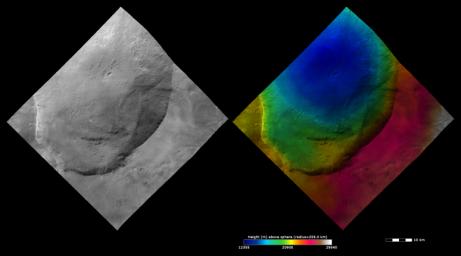These Dawn FC (framing camera) images show Marcia crater, after which Marcia quadrangle is named. Marcia crater is the largest and southernmost of the three Vestan craters nicknamed the 'Snowman.' The left image is an albedo image, which is taken directly through the clear filter of the FC. Such an image shows the albedo (e.g. brightness/darkness) of the surface. The right image uses the same albedo image as its base but then a color-coded height representation of the topography is overlain onto it. The topography is calculated from a set of images that were observed from different viewing directions, allowing stereo reconstruction. The various colors correspond to the height of the area. The white and red areas on the right of the image are the highest areas and the blue area in the center of Marcia crater is the lowest area. Marcia crater is a fresh crater with an irregularly shaped rim, which is clear in both the albedo and color-coded height images. Dark material cropping out of the rim and slumping into the center of Marcia crater is visible in the albedo image. The right side of Marcia crater has a reasonably steep slope, which is clear in the color-coded height image as the relatively rapid change in colors towards Marcia's center.
These images are located in Vesta's Marcia quadrangle and the center latitude and longitude of the image is 5.8°N, 191.3°E. NASA's Dawn spacecraft obtained this image with its framing camera on October 23rd 2011. This image was taken through the camera's clear filter. The distance to the surface of Vesta is 700 km and the image has a resolution of about 70 meters per pixel. This image was acquired during the HAMO (High Altitude Mapping Orbit) phase of the mission. The images are lambert-azimuthal map projected.
The Dawn mission to Vesta and Ceres is managed by NASA's Jet Propulsion Laboratory, a division of the California Institute of Technology in Pasadena, for NASA's Science Mission Directorate, Washington D.C. UCLA is responsible for overall Dawn mission science. The Dawn framing cameras have been developed and built under the leadership of the Max Planck Institute for Solar System Research, Katlenburg-Lindau, Germany, with significant contributions by DLR German Aerospace Center, Institute of Planetary Research, Berlin, and in coordination with the Institute of Computer and Communication Network Engineering, Braunschweig. The Framing Camera project is funded by the Max Planck Society, DLR, and NASA/JPL.
More information about Dawn is online at http://dawn.jpl.nasa.gov.

 Planetary Data System
Planetary Data System












